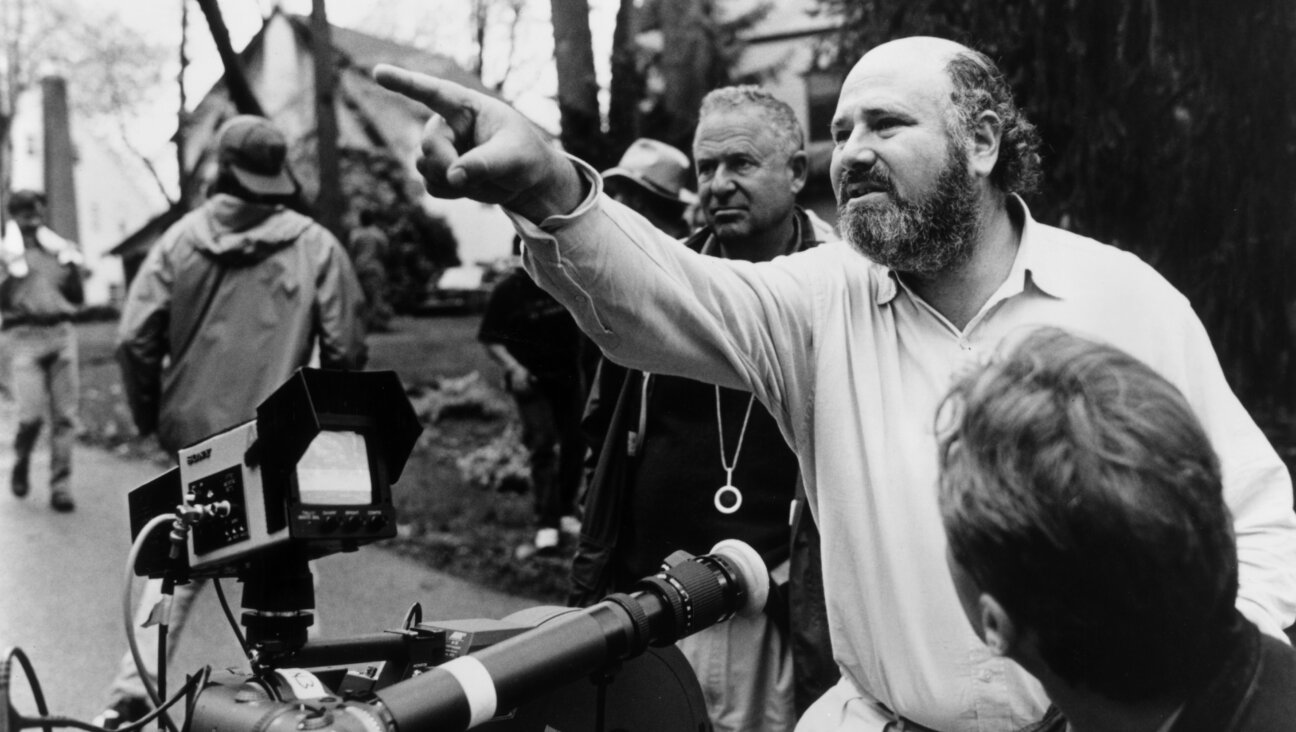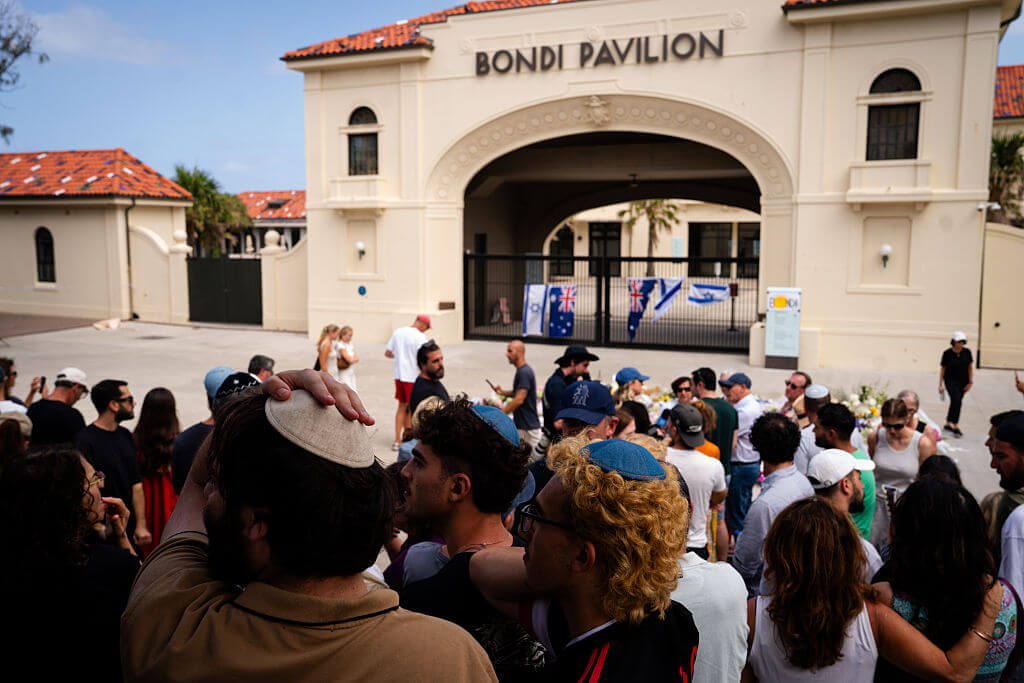The Inconvenient Truth About Jews From Arab Lands: They Were Expelled

Seeking Refuge: Yemenis gather around the ruins of buildings in the Jewish quarter after riots broke out. Image by getty images
(Haaretz) — Nathan Weinstock hadn’t planned to write a book about the Jews of Arab lands. But when he looked for information about the modern history of Moroccan or Iraqi Jewry, he was surprised to discover that there was no book in French that told the story of the elimination of the Jewish communities in the Middle East and North Africa in the mid-20th century.
“In the end,” he says, “I decided to write it myself.”
One of the surprising discoveries he made was about the powerful bond with their roots felt by many of the roughly 1 million Jews in North Africa and the Middle East who left their homes in the decade after the creation of Israel.
“The story I knew,” Weinstock relates in a Skype interview from his home in Nice, in the south of France, “was that the Jews were happy to leave the Arab countries the moment they were given the opportunity to do so. We were not told anything about the Jews’ deep connection with Arab culture, for example. It was only later that I learned that Jewish writers were the foundation of Iraqi literature. And that in mid-19th-century Egypt, the man who invented the nationalist slogan ‘Egypt for the Egyptians,’ and was known as ‘the Egyptian Molière,’ was a Jew named Jacob Sanua.
“In the course of my research,” he continues, “I found out that the story we had been told – that the Jews left the Arab countries because they were Zionists – was for the most part wrong. True, they had an affinity for the Land of Israel – that is certainly correct – but the organized Zionist movement was very weak in the Arab countries. The great mass of Jews left under duress. They were expelled. They were subjected to such enormous pressure that they had no choice but to leave.”
Weinstock, a self-taught historian, now in his 70s, who previously published studies about the Bund movement in Eastern Europe and Yiddish literature, decided to assume the task of chronicling the expulsion of the Jews from the Arab countries. The result is a book that was published in France in 2008 as “Une si longue présence: Comment le monde arabe a perdu ses Juifs, 1947-1967” (“A Very Long Presence: How the Arab World Lost Its Jews, 1947-1967)” and has now appeared in Hebrew (Babel Books; translated by Hagit Bat-Ada).
This is a very thorough, detailed, interesting and persuasive book, with more than 900 footnotes, and it is one of the first to deal in this context with the Jewish minority in Ottoman Palestine. Weinstock has mostly relied on secondary sources, but has also used some primary sources in French from the archives of the Alliance Israelite Universelle in Paris, for example.
What makes Weinstock’s decision to write about the Jews’ expulsion from the Arab world especially surprising is his own political biography: He was one of the leading figures in the anti-Zionist left in France during the 1960s and ‘70s. From viewing Israel and Zionism as a colonial project aimed at dispossessing the Palestinians, Weinstock underwent a dramatic conceptual upheaval that led him to address a painful and rarely discussed aspect of the Arab-Israeli conflict.
“This book is the story of a tragedy,” he writes in a special introduction to the Hebrew edition, “of the uprooting of hundreds of thousands of Mizrahi Jews, who were torn cruelly from their homes and homelands. Whole communities of Jews, who had always resided in the heart of the Arab-Muslim world, underwent expulsion, persecution and malicious liquidations… Nevertheless, this drama remains unknown and it has been denied for a lengthy period.”
Weinstock, who was born in Antwerp in 1939, espoused anti-Zionist, pro-Palestinian views even before the 1967 Six-Day War. As such, he was invited, three weeks before the war’s outbreak, to speak to the Palestinian students’ union in Paris. The Paris correspondent of the Israeli newspaper Maariv, Uri Dan, reported about the event at the time: “Most depressing of all was the appearance of Nathan Weinstock, a Jew, who had a place of honor on the stage and delivered the keynote address… Weinstock was even more extreme than the Arabs in the abuse he hurled against Israel.”
In retrospect, Weinstock explains, that event showed him the degree to which he played the part of the “useful idiot” at the time. “I was thrilled when I got up to speak to the Palestinian students,” he told me. “Very naively, I was convinced that the Palestinian students would be happy to hear my pacifist message. So I was astonished when not one of them showed the least interest in what I said. Instead, they listened ecstatically to Radio Cairo, delighting in every word and swallowing the boastful announcements that the Arab armies would soon throw all the Jews into the sea.”
In 1969, Weinstock published “Zionism: False Messiah,” an anti-Zionist pamphlet (in French; an English translation came out a decade later) that quickly became the bible of anti-Israeli propaganda in France. Gradually, however, he says, he became aware of “the anti-Semitic nature of the blind assault on Israel. First, ‘the Zionists’ are condemned, then the ‘Zionist takeover’ of the media, and finally ‘Zionist world domination.’ When I was quoted, my criticism of the Palestinians, however minor, was always omitted. In the end, I understood that I had been used. My listeners took no interest whatsoever in me. For them, I was a Jewish alibi for their anti-Jewish posture.”
The straw that broke the camel’s back for Weinstock was the failure of the Camp David summit in 2000. “Once again the Palestinian leadership avoided taking responsibility,” he says. “The Palestinian leadership was cowardly, declining to tell their nation that one has to know when to conclude the struggle, because the central goal has been achieved.”
How do you account for your polar reversal of position – from anti-Zionist guru of the radical left as a young man, to supporter of Israel today?
“In the 1960s I was under strong Trotskyite influence, and I took a doctrinaire approach to issues – not based on a genuine attempt to analyze them, but in order to adjust them to simplistic, pre-set positions. The radical left has not reconsidered that period, and in many senses sounds exactly the same today. When one looks at who supports the Palestinians in Europe – and it is clear that the Palestinians do indeed have rights that need to be addressed – one sees that they don’t care about anything else: not the Armenians, not the Cypriot-Greek issue, not what’s happening in Western Sahara. Only one thing interests them, and I cannot accept that.
“We also need to remember,” he continues “that Israel took a self-righteous stance in that period, and it was very difficult to voice criticism about its behavior. In the meantime, a generation of ‘new historians’ sprang up in Israel, such as Benny Morris, who took a realistic view of history. As in every country, there are dark areas in Israel which need to be examined. But has there been any country in history without dark corners that were kept hidden? This process is underway in Israel today – but where are the Palestinian ‘new historians’? To emerge from the tangle, the Palestinians must show courage and choose the path of coexistence with the Israelis. This is a task that only they can perform for themselves.”
In 1945, Weinstock notes, almost one million Jews lived in the Arab world, whereas today there are about 4,500, the great majority of them in Morocco. According to Weinstock, there is no precedent for such a dramatic termination of Jewish communities anywhere in the world, including during the Holocaust. What, then, brought about the massive departure of Jews from the Arab countries? It was not Zionism that disconnected the Jews from their surroundings, he says. On the contrary: In most cases, the Zionist movement had a hard time mustering supporters. Jews also tried to become part of the Arab national-liberation movements. For example, the chief rabbi of Egypt during the mid-20th century, Chaim Nahum, often spoke out against Zionism; in Iraq, Jewish communists founded the Anti-Zionist League. Activist Jewish communists in North Africa expressed solidarity with the Maghreb peoples and were in the forefront of the demand for national liberation.
Weinstock cites a large number of attacks and pogroms against Jewish communities that are rarely mentioned in history curricula in Israel. In 1912, 12 Jews were killed in Shiraz, Iran, and 51 were killed that year in Fez, Morocco. In 1934, 25 Jews were killed in the Algerian city of Constantine.
In Iraq, 150 Jews were murdered in the Farhud of 1941, a three-day pogrom. Seven years later, upon Israel’s establishment, Iraq declared martial law and launched a wave of anti-Jewish persecutions. Many Jews were arrested, tried and convicted, some were sentenced to death, others were given jail terms or slapped with large fines. At this stage, the Jews were forbidden to leave the country, but in March 1950 Iraq allowed the Jews to emigrate, provided they gave up their citizenship and their property.
“The ongoing deterioration in the Jews’ situation and the atmosphere of hate surrounding them led to a mass flight from the country,” Weinstock writes.
The majority of the Jewish population (90 percent of the community of 150,000) left that year, amid a massive plundering of their property by the authorities.
In Egypt, anti-Jewish disturbances broke out in November 1945, on the anniversary of the Balfour Declaration, but the declaration of the State of Israel three years later triggered serious persecution. Hundreds of Jews were arrested, accused of involvement in Zionist or communist plots and had their property confiscated. Continuous attacks on Jews began that June. Bombs were planted in the Jewish quarter of Cairo, and it and the Jewish section of Alexandria were set ablaze. Half the country’s Jewish community left at that time, with the remainder being expelled during the Sinai War of 1956. The Jews who were driven out were not allowed to take with or sell their property.
“The police arrived and pulled grocers, carpenters, woodworkers and glaziers – but also well-known lawyers – from their beds,” Weinstock writes.
Is there anything in common among the different communities?
“Yes, in terms of the legal and social status that the Jews shared under Islamic rule. They possessed dhimmi status, meaning ‘protected person.’ It afforded the Jews the authorities’ protection, but at the same time placed them in an inferior position, humiliated and scorned. Jews were not allowed to bear arms in these countries, in which carrying a weapon was considered a salient sign of manhood. In some cases, as in early-19th-century Morocco, Jews were made to go about barefoot, or to wear humiliating clothes.”
In return for protection by the government, the Jews had to pay a special tax. “Nothing better describes the contempt entailed in the status of dhimmitude,” Weinstock writes, “than the ritual of humiliation that accompanied the annual payment of the subjugation tax in Morocco, as recently as the end of the 19th century. Every year, on a fixed date, the head of each Jewish community had to turn over the money to the sultan’s representative, who for his part had to slap [the Jew] or hit him with a stick in order to hammer home the inequality between giver and recipient, by nature of their birth.”
In Yemen, the “Latrines Ordinance,” introduced in the same spirit, obliged the Jewish community periodically to clean out cesspools and clear away animal carcasses that blocked public roads. (The law remained in force until 1950.)
Weinstock describes a very different state of affairs from the oft-voiced myth about the harmonious relations between Jews and Arabs under Islamic rule. Less than 100 years after the Ottoman sultan invited the exiles from Spain to settle throughout his empire, for example, one of his descendants, Murat III, ordered “the liquidation of all the Jews.” The sultan’s Jewish physician persuaded his mother to intercede, and the order was rescinded.
Over the years, numerous laws were enacted that discriminated against the Jews – from a prohibition against horseback riding to the necessity of wearing particular clothing, and from a ban on giving testimony in court to a prohibition against building homes over a certain height.
At the same time, Weinstock notes, the laws were not enforced identically in every place and in every period. For example, a study of the Cairo Geniza documents, which date back to the ninth century, shows that the clothing regulations were not observed at all.
“There were periods in which the Jews succeeded very well in the Muslim world,” Weinstock says. “At times they were part of the elite. The dhimmi regulations and the scale of humiliation also differed from place to place and from one period to another. But the central axis that dictated the attitude toward the Jews was their dhimmi status, which meant subjugation to the ruling Muslim group.”
Weinstock quotes a Moroccan sultan saying in the mid-19th century: “Our glorious religion grants them only marks of opprobrium and inferiority.”
Weinstock also examines the situation in the Holy Land through the dhimmi prism. The Jewish minority that lived under Ottoman rule experienced humiliation and subordination, he says. Anti-Jewish riots were fomented time and again in the 18th and 19th centuries. He quotes the British consul in Palestine as writing in 1831 that the extortion and acts of suppression against the Jews were so numerous that it was said “that the Jews have to pay even for the air they breathe.”
In the twilight of Ottoman rule, a century ago, the first “Hebrew city” was founded (present-day Tel Aviv), a revival of the Hebrew language began to be felt, and Jewish cooperative farming settlements were established. The local Arab population, Weinstock says, felt that the ground was being pulled from under it, as the dhimmi Jews, who were supposed to possess inferior status, were now striving for more – even for independence.
According to Weinstock, underlying the growing hostility toward the Jewish population in Palestine was the realization that the dhimmi Jews were shaking off their traditional legal status of humiliation and submission. In retrospect, the writer maintains, dhimmi status, on the one hand, and the declared attempt by the Zionist movement to be free of it, on the other, led ultimately to the Arabs’ rejection of the United Nations partition plan in 1947 and to the War of Independence the following year.
Local Palestinians and the Arab world refused to grant the Jews of the country a status different from dhimmi, and they were even less likely to recognize the Jews’ national rights. Zionism, for its part, could not accept Arab sovereignty over all of Palestine, a situation in which the Jewish minority would again find itself under dhimmi status. “Historically, then,” Weinstock says, “dhimmi status is the root of the conflict.”
What impact does this relationship have today?
“It continues to affect Israeli-Arab relations even today, because in Arab eyes the Jew who now lives in Israel is the same Jew whom they customarily saw as humiliated – and who is now taking his revenge. The Arabs experience Israel’s establishment and existence to this day as very painful revenge and as the reversal of dhimmitude. This is a very meaningful and deep aspect of the current political problem, which we cannot allow ourselves to ignore. Without understanding this, it is impossible to understand the conflict.”
Then why is it not dealt with more by academics and the press?
“For the Jewish world, the reason is that Ashkenazi Jews, in Israel and elsewhere, continue to be indifferent to and even disdainful of the Mizrahi Jews. For the Arab world, this should come as no surprise, as self-criticism is not popular among Arab journalists, intellectuals and public-opinion leaders. With the exception of a very short incidental note by [the late Prof.] Edward Said in one of his books, it is hard to find serious references to the massive emigration of Jews from the Arab countries and its causes.
“The left tends to avoid the subject, because they don’t consider it ‘kosher.’ The left has become extraordinarily dogmatic and lacks the ability of self-criticism today. People define themselves as identifying with ‘the Palestinian cause,’ and that’s all: There is no thought behind it. This subject might upset their one-sided worldview, so they simply avoid it.
__Jewish history is one long story of seeking refuge. From Hitler’s Berlin to Soviet Moscow, from fundamentalist Teheran to chaos-ridden Addis-Ababa — read more of Jewish refugees’ stories here._
This story originally appeared on June 1, 2014.















